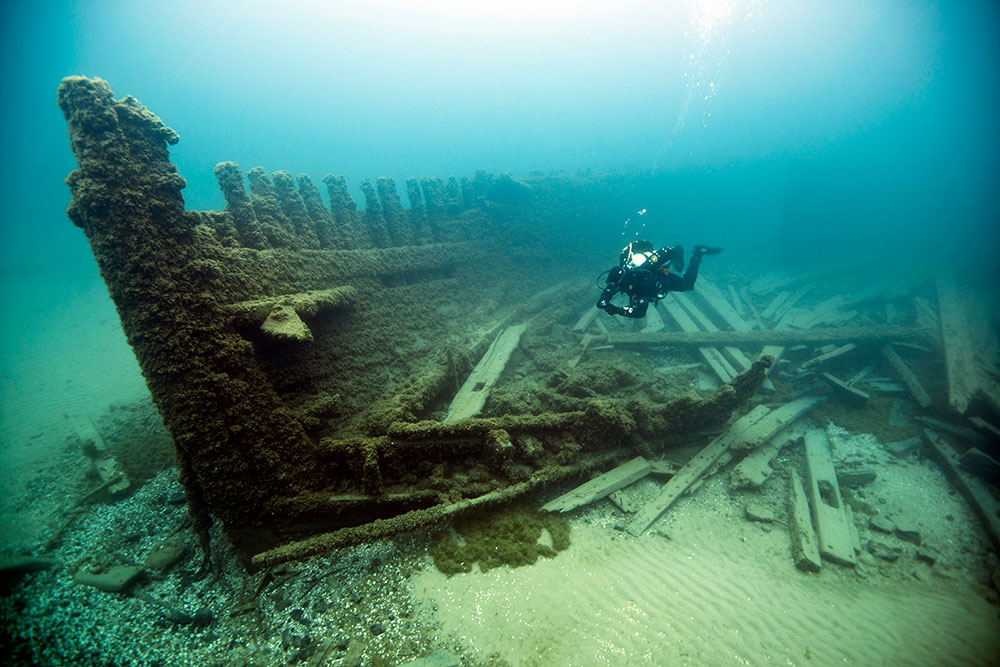National Marine Sanctuaries – Value Added for Communities and the Blue Economy
by Chiara Zuccarino-Crowe
December 2016
If you were asked to draw a picture of the U.S. economy, what color would you use? Perhaps green, the color of money? How about the portion of the economy that is supported by our ocean and coasts? BLUE!

Now think about what it feels like to be surrounded by blue seas – perhaps while casting out a line and peacefully waiting to feel the tug of a fish. Do you see that huge ocean liner on the horizon? Ever wonder which U.S. port it’s headed for? That ship, your boat, the fuel you used to get out there, the fishing rod in your hands – it’s all part of the “blue” or ocean economy. Including industries like maritime commerce, offshore mineral extraction, fishing, and coastal tourism, this ocean economy amounts to hundreds of billions of dollars in goods and services, and it supports millions of jobs each year.
More than half of the U.S. population is concentrated along coasts. The National Oceanic and Atmospheric Administration (NOAA) recognizes the importance of healthy marine and Great Lakes systems to communities and the U.S. economy. Take fun stuff, for example -- like tourism and recreation. These sectors are substantial, and they benefit when coastal communities’ maritime heritage and environments are studied, protected, and promoted. This supports the celebration of a region’s traditions and resources, attracting visitors who want to enjoy the local culture, seafood, surf breaks, beaches, and water sports. Ultimately, this awareness of unique resources and communities builds the grassroots support for their conservation.
This concept of place-based conservation provides a collaborative way to achieve a balance between potentially competing demands in key areas. NOAA’s Office of National Marine Sanctuaries exemplifies this approach by working with communities to protect iconic ocean and Great Lakes places for the benefit of current and future generations. This includes mementos of America's past as a seafaring nation, including prehistoric sites, shipwrecks, and naval battlefields – all conduits to explore and appreciate our country's maritime cultural heritage. Sanctuaries also include areas of natural significance, like key breeding and feeding grounds of humpback whales – protected places where people can witness these gentle giants in their natural habitats performing innate, and surprisingly acrobatic, behaviors.
From the Florida Keys to American Samoa, national marine sanctuaries are a special type of ocean economy hotspot – iconic destinations that can help support sustainable blue economies. Across the sanctuary system, about $8 billion annually is generated in local coastal and ocean dependent economies from diverse sectors like commercial fishing, research, and tourism-related activities.
Consider recreational fishing. For many coastal communities, anglers are the lifeblood of the local economy, supporting bait and tackle shops, boat sales, hotels, and other businesses. For example, $155.6 million on average is spent annually on recreational fishing in the four national marine sanctuaries located along the California coast. This spending supports an average of 1,400 jobs, and generates $213.1 million in sales and output and $74.6 million in income in local communities.
Even in more remote locations, like Olympic Coast National Marine Sanctuary on Washington’s Olympic Peninsula, recreational activities provide substantial benefits. In 2014, Washington state residents made 833,000 trips out to the Olympic Coast for recreation, pursuing activities like wildlife watching from shore or boat (three cheers for charismatic otters and orcas!), beachgoing, and hiking. People spent $102 million while recreating in the sanctuary, generating $128.2 million in output and sales, $46 million in income, and 1,200 jobs in the local economy.
On the opposite end of the sanctuary system, a 2007-08 study of recreation-tourism in Florida Keys National Marine Sanctuary calculated that visitors and residents spent $2.1 billion while engaged in tourism and recreational activities. This spending had an impact on the local Monroe County economy of $2.4 billion in output and sales and $1.0 billion in income, and supported 33,600 jobs. Planning for a decadal replication of this study is currently underway, which includes an opportunity for partners and constituents to weigh in on past successes of the former analyses and suggestions for improvement.
Additional examples of these socioeconomic impacts abound throughout the sanctuary system, where sanctuaries continue to build stronger communities, support local economies, and maintain coastal cultures – true American treasures. So next time you visit the coast, remember to enjoy the blue view, and feel good about the fact that your green dollars are supporting something worth protecting.

